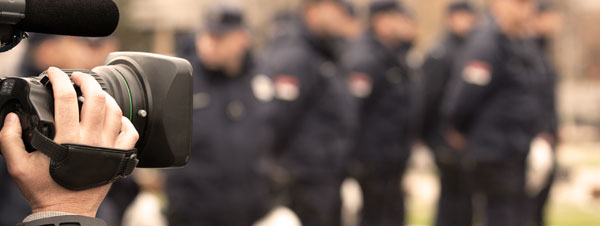

Learn as much background as possible about a community and a situation before arriving on the scene.
Do your best to make sure that video and still images authentically represent the action that unfolded as well the diversity of those who participated.
Edit video so that you accurately represent the breadth of voices and viewpoints and tell the entire story as it developed. Interview as many people as you can but remember that eyewitness accounts can be misleading or inaccurate.
Be wary of citizen journalists, who may champion a particular point of view.
Be cautious about sharing information from social media sources while on the scene as the situation unfolds. Citizens often get much of their information from social media, which can often be wrong. False information can spread quickly and inflame an already tense situation.
If you do share information with citizens, make sure it is verified and that it is unlikely to further inflame the situation.
Participants in demonstrations and counter demonstrations may attempt to provoke or engage you. Keep your cool and remain neutral.
No story is worth jeopardizing your safety, the safety of a colleague or valuable equipment. Remain aware of your surroundings. This includes exercising caution while looking at a mobile device to communicate via text messages or post social media.
Communicating in advance and having relationships with law enforcement is invaluable. Avoid turning bright lights on officers in tense situations as they might view it as putting them under a spotlight.
Be aware of the of signal that your bright light sends. Waiting until the live shot to turn on a light will draw protesters and tell them exactly when to jump in front of the camera or do something that might be inappropriate. A dry-run live shot can help flush out anyone with such intentions.
Shooting footage of an unstable situation can make you a target. Balance your journalistic responsibility with your need for personal safety.
In volatile situations, the field team must remain together at all times.
Be careful not to allow the crowd to come between you and law enforcement officers.
Do not leave your equipment unattended. It could be damaged or taken.
If an environment does not feel safe, move immediately to one that does. Leave yourself an escape route. Notify your producer or manager of the situation as soon as possible.
Park your vehicle in a place that allows for a quick escape from a potentially unsafe situation. Park in a well-traveled, well-lighted public area or a secured garage.
Avoid staying in one place too long. Cameras and lights can draw groups of people to your location.
When faced with any type of confrontation, turn the camera on and let it roll. The video and audio are great for verifying and corroborating.
When confronted by an angry individual, allow them to go on camera to vent, even if you do not expect the footage to be used. This can diffuse a tense situation.
If there is a large crowd (i.e. Ferguson), find out whether there is someone in charge with whom you can communicate. This could be a group leader or police officer. Keep in mind that participants in a spontaneous, grassroots demonstration may not have a leader.
Remain vigilant in the presence of crowds, understanding that some individuals in a group that has spontaneously gathered during a period of unrest might be carrying weapons or objects that can be thrown.
If you must take refuge in a vehicle to avoid tear gas, do NOT turn on the air conditioning. It can circulate the gas into the car.
Consider hiring a security guard to assist the news crew in getting out of harm's way. Be careful if you do have a uniformed security guard with you since they may be seen as a law enforcement officer.
Managers should take into consideration the physical and mental effects of covering these high-stress, volatile events. Sending the same people out night after night can quickly lead to burnout.
